Peace Labyrinth: Quilting the Golden Rule
Artist’s Statement
Janet Bear McTavish
“I had been concerned for some time about the increasing fear that I saw among many Americans after the events of 09/11/2001. I began to see people classifying others on the basis of race, religion, looks, and clothing to the point where people were being discriminated against, profiled, banned from public transportation and even arrested because of the fear of some and the silence of others. The idea (for Peace Labyrinth) came from a dream in which I was walking a labyrinth in which I passed cubicles representing all the world’s major faith and religions. On the way in I was learning about each one and on the way out I was walking behind the cubicles where I saw displayed their version of what we call ‘The Golden Rule.’ In my dream, I also cared a rock with me that represented all the negativity and uneasiness people feel when confronted with new ideas, different perspectives, and cultures that are unfamiliar. When I reached the center of the labyrinth, I came to a peaceful waterfall where I was encouraged to leave my rock and my own discomfort behind and to find peace.
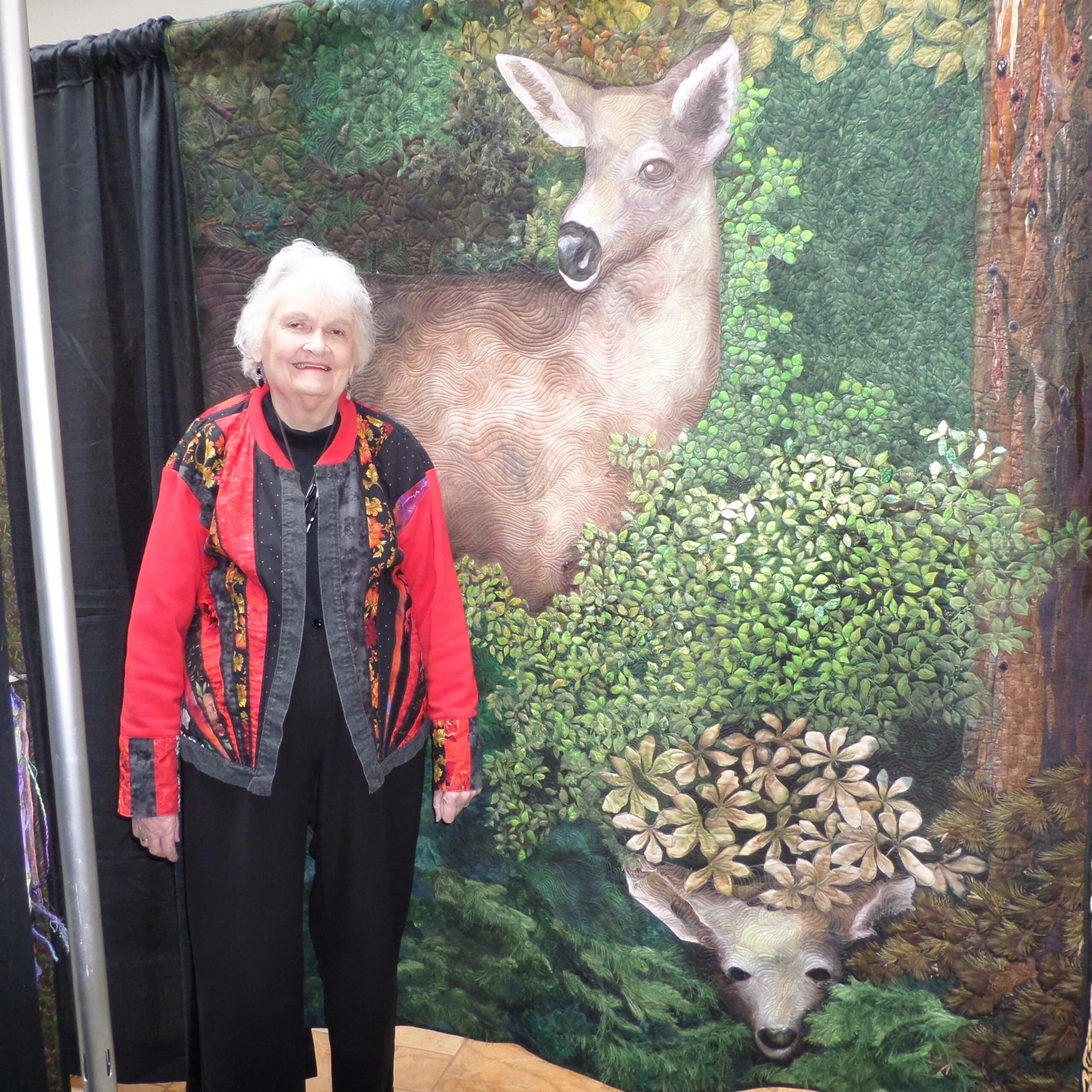 I then passed through a garden where I was encouraged to share the peace and love that I had found with everyone I met. When I awake from this dream, I realized that […] what is needed is information– not sound bites and propaganda […] I knew I needed to share what I had learned with others.”
I then passed through a garden where I was encouraged to share the peace and love that I had found with everyone I met. When I awake from this dream, I realized that […] what is needed is information– not sound bites and propaganda […] I knew I needed to share what I had learned with others.”
Art: Angel of Peace
ANGEL OF PEACE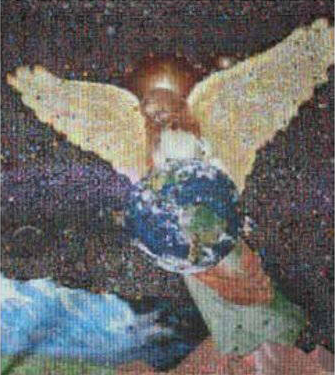
Designed and pieced by Janet McTavish and machine quilted by Karen McTavish (2007)
This quilt is a mosaic of 11,400 3/4″ square pictures of people, places and things from all over the world. It has been shown in a number of national and international quilt shows including the International Quilt Festival 2007 in Houston, TX. The idea came from a dream Mrs. McTavish had where an angel was holding up the planet Earth – a prayer that we might learn to live in peace and with each other and our environment.
Baha 'i Faith
BAHA’I
“Ascribe not to any soul that which thou wouldst not have ascribed to thee, and say not that which thou doest not.” (Baha’u’llah)aha’is believe God has revealed his will to humanity through a series of Divine messengers from Abraham to the latest Baha’u’llah (1817-1892) who founded the Baha’i faith in Iran in 1844. Baha’is believe that the Baha’u’llah fulfills the prophecy of the Promised One as revealed in all religions, the second coming of Christ.
The central theme of Baha’u’llah’s message is that “humanity is one single race and the day has come for unification into one global society” that respects the equality and rights of all people regardless of gender, race, ethnicity and national boundaries.
In keeping with the teachings of Baha’u’llah, Bahai’is are encouraged to work for social justice among people, basic human rights, stewardship and sharing of environmental resources, and the establishment of enduring international peace. Baha’is are encouraged to work on issues – not politics.
Buddhism
BUDDHISM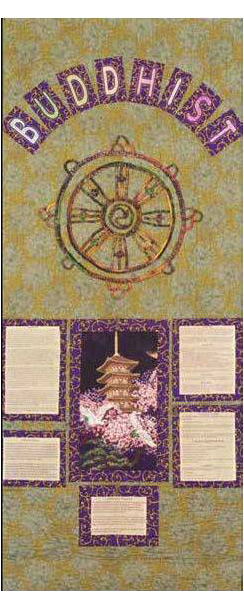
“. . . a state that is not pleasing or delightful to me, how could I inflict that upon another?” (Samuitta Nikaya v. 353)
The roots of Buddhism lie in the religious thought of ancient India. The philosophy of Buddhism began with the teachings of Siddhartha Gautama (566-486 BCE), who as a prince was protected by his parents from seeing the suffering of others. Discontented and curious, he left a wife and child to see what life was like outside the palace walls. Haunted by what he saw, he took up a spiritual quest and eventually reached enlightenment in 531 BCE. He then traveled throughout India to teach the path to enlightenment or “Dharma.”
For the next 200 years Buddhism was spread orally by monks who carefully memorized Buddhist teachings. In the 3rd century BCE, Buddhism began to flourish after the Emperor commissioned the first written record of Buddha’s teachings, carved in stone, including the Four Noble Truths and the Noble Eightfold Path. Committing to being on the Buddhist path is to take refuge in the Three Jewels: The Buddha, the Dharma (his teachings) and the Sangha (Buddhist community).
Christianity
CHRISTIANITY
“And as you wish that others would do to you, do so to them.” (Luke 6:31)
Christianity was formed out of Judaism in 33 CE and founded on the life, teachings, death and resurrection of Jesus of Nazareth, believed by his followers to be the Messiah (Christ). Subject to persecution and death at first, Christians grew in number and in 380 CE the Roman Empire officially adopted Trinitarian Christianity as its state religion, as set by Nicene Counal. As the church grew, conflicts arose over leadership and theology and splits occurred in Western Europe and later in the Americas, leading to multiple sects, denominations and practices.
Most of what is known about the life and teachings of Jesus comes from the Bible (the Gospels Mark, Matthew, and Luke). He taught love for others, including one’s enemies. He questioned practices that created inequality and suffering. He taught humility and compassion and to resist judgment and greed. Christians believe that there is only one God and recognize Jesus as the Son of God who was sent to save mankind from death and sin. Jesus’ teachings can e summarized briefly as the love of God and love of one’s neighbor.
Confucianism
CONFUCIANISM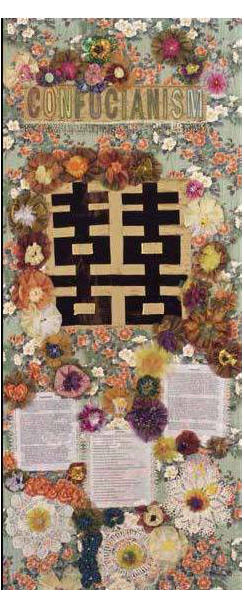
“Do not do to others what you do not want them to do to you.” (Analects 15:21)
Confucianism is an ethical and philosophical system, originally based on the teachings of Confucius (551-213 BCE), a thinker, teacher and founder of the RU School of Chinese thought. What little survives of his teachings is in The Analects book of the Confucian Canon, compiled in the late 12th century CE.
The overall goal of Confucianism is to educate people to be self-motivated, self-controlled and to assume the responsibilities of their station in life. Confucius believed that people were born into a particular place in society and if they acted according to their position, ethically and sincerely, the community would operate smoothly, and discord would be avoided. Women were considered to be low in the hierarchy and were kept under strict control. Confucius valued education and also taught that within education there should be no social class. His ideas had great influence culturally and intellectually and became an essential element of the Chinese state.
Hinduism
HINDUISM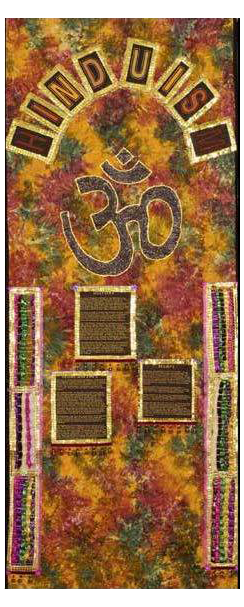
“This is the sum of duty: do not do to others what would cause pain if done to you.” (Mahabharata 5:1517)
Hinduism reaches back beyond 2000 BCE to the Bronze Age civilization of the Indus Valley and developed from three indigenous cultures: Aryans that migrated into India from what is now Iran, Northern India (present day Pakistan) and Southern India. The source of Hindu teaching are the hymns, poems and instructions known as “The Vedas,” which were handed down to each generation by persons trained to memorize, forwards and backwards, carefully constructed chants and poetic verses that fit with those of others to ensure the integrity of the precise message.
Hinduism embraces a diversity of beliefs. One can believe a variety of things about God or gods, the universe and the path to liberation and still be considered a Hindu. Perhaps the most well-known Hindu saying about religion is “Truth is one; sages call it by different names.” Still, there are some fundamental beliefs common to nearly all forms of Hinduism the authority of the Vedas (the oldest Indian sacred texts) and the Brahmans (priests); the existence of an enduring soul that transmigrates from one body to another at death (reincarnation); and the law of karma (one’s moral actions have unavoidable and automatic effects on one’s fortunes in this life and condition of rebirth in the next).
Islam
ISLAM
“None of you believes until he wishes for his brother what he wishes for himself.” (Number 13 of Imam Al-Nawawi’s Forty Hadiths)
Muslims believe that there is only one God, Allah, whose Truth was revealed through the prophets Abraham, Moses, Jesus, and most recently Mohammed (570-632 CE), who founded Islam in 622 CE in Mecca. Muslims believe that he came to correct previous messages that had become distorted over time. His teachings are preserved in their holiest of books, The Qur’an Muslims believe in angels, the “Day of Resurrection” and predestination. They also believe that humans are given free will to choose between right and wrong. Islam is the second largest religion in the world, making up about 23% of the world’s population and living in almost every part of the world. The majority of Muslims belong to one of two denominations: the Sunni and the Sh’ia. Some devout Muslims questions the worldly life and conquest of others, and this has inspired a third movement, Sufism.
Jainism
JAINISM
“A man should wander about treating all creatures as he himself would be treated.” (Sutrakritanga 1:11.33)
Jainism is an Indian religion that prescribes a path of non-violence, believing that all living things contain living souls of equal value and should be treated with respect and compassion. Practitioners believe in re-incarnation and that non-violence and self-control are means by which they can obtain liberation.
Jains traditionally trace their history through a succession of twenty-four propagators of their faith known as tirthankaras, ordinary souls who appear in the world to teach the way to liberation. Scholars date the present form of Jainism to sometime between the 9th and 6th centuries BCE, making Jainism one of the oldest religions in the world.
For long periods of time Jainism was the state religion of Indian kingdoms and was widely adopted in the Indian subcontinent. However, this faith has been in decline since the 8th century CE due to the growth of Hinduism and Islam and now is a religious minority in India. Jains have the highest degree of literacy of any religious community in India (94.1 percent), and their manuscript libraries are the oldest in the country.
Judaism
JUDAISM
“What is hateful to you, do not to your fellow man. This is the law; all the rest is commentary.” (Taknydm Sgabbot 31)
Judaism is the original of the three Abrahamic faiths, which also include Christianity and Islam, and originated in the Middle East over 3500 years ago. Although Jews trace their history back to Abraham, Judaism was founded by Moses who received the Ten Commandments from God. Jews believe that there is only one God with whom they have a covenant. In exchange for all the good that God has done for the Jewish people, Jews strive to keep God’s laws and to bring holiness into every aspect of their lives. Throughout their history, they have experienced much persecution, suffering, slavery and exile, yet believe that God is loyal to the children of Isreal. Judaism did not accept Jesus or Mohammad as the Messiah because they did not fulfill the messianic prophesies of the Old Testament. However, they believe that Christianity and Islam are part of God’s plan to move society closer to perfected state of morality and greater understanding of God.
Native American
NATIVE AMERICAN
“All things are our relatives; what we do to everything, we do to ourselves. All is really One.” (Native American Spirituality, Black Elk)
Although the original Native American religions were suppressed and influenced by Christianity after the arrival of Europeans, efforts are now underway to revive Native culture and religious practices. Traditional Native American ceremonial ways can vary widely and are based on the differing histories and beliefs of individual tribes, dans and bands. Native American theology may be monotheistic, polytheistic, henotheistic, animistic, or some combination thereof. Traditional beliefs are usually passed down in the forms of oral histories, stories, allegories and principles, and rely on face-to-face teaching in one’s family and community. Native American spirituality stresses respect for the environment and for the wisdom of elders. It teaches family and community responsibility. Beliefs and religious practices differ among tribes, but they all attempt to explain how things came to be, like the Creation Story, areas of supernatural concern and major changes of birth, puberty and death. They recognize the interconnectivity of the natural and spiritual worlds and emphasize personal responsibility for growth. Stories told to children have a moral to them and often involve animals. Religion is a part of daily life.
Shinto
SHINTO
“The heart of the person before you is a mirror. See there your own form.” (Ko-ji-ki-Hachiman Kasuga)
Recorded Shinto history dates back to 712 CE but archeological records date back significantly further. Shinto has roots in oral traditions and stories and is a set of rites & practices to cleanse the spirit of impurity and to find peace of mind and good fortune. Shinto is “polytheistic” in that it includes many Kami or deities, which may be anything that inspires unusual awe, whether it is good or evil. By making offerings to the Kami, it is thought that good fortune may be gained and evil placated. After becoming the state religion in 1868 of the Empire of Japan, attempts were made to abolish many Confucian and Buddhist beliefs with which Shinto previously had coexisted. State Shinto became increasingly militaristic until Japan lost the war in the Pacific in 1945. Shrines have since been used to seek good fortune and for remembrance of ancestors.
Sikh
SIKH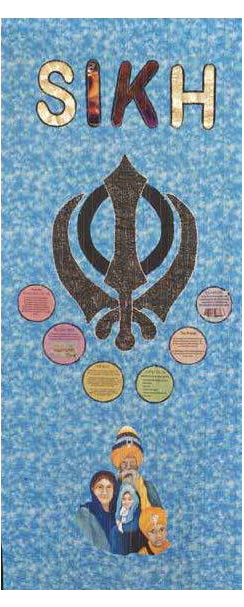
“Compassion-mercy and religion are the support of the entire world.” (Japji Sahib)
The Sikh faith was founded by Shri Guru Nanck (1469 – 1538), who was born in what now is called Pakistan. After receiving a vision, he began to preach the way to enlightenment. He taught monotheism and rejected idol worship and the Hindu caste system and preached the equality of all humanity, regardless of gender, race, religion, ethnicity or socio-economics status. Sikhs believe in one God and in reincarnation and Karma (the accumulation of one’s good and bad deeds). They have a strict prescribed code of clothing rules, such as wearing head coverings from infancy on throughout adult life to keep their hair neat and clean. Drinking intoxicating substances and adultery are forbidden.
Taoism
TAOISM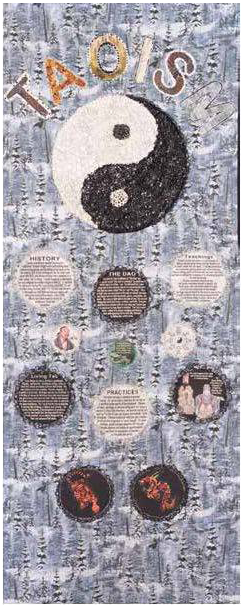
“Regard your neighbor’s gain as your own gain, and your neighbor’s loss as your own loss.” (T’ai Shang Kan Ying P’ien)
Taoism is an ancient tradition of philosophy and religious belief that originated in China as early as the 4th century BCE and is deeply rooted in Chinese customs and worldview. (Taoism is also referred to as Daoims). The Tao, which usually is translated as The Way, originally meant “the road or principle” that one should follow. When living Tao, three things are above all else in importance: gentleness, frugality and humility. The Tao also is the ultimate creative principle of the universe, where all things are unified and connected. Taoism is a religion of unity and opposites; Yin and Yang, which need to be kept in balance. The principle of Yin Yang sees the world as filled with complementary forces – action and non-action, light and dark, hot and cold and so on. Although the Tao is not God and is not worshipped, Taoism includes many deities that are worshipped in Taoist temples. These deities are part of the universe and depend, like everything else, on the Toa.
Unitarian Universalist
UNITARIAN UNIVERSALIST
“We affirm and promote respect for the interdependent web of all existence of which we are a part.” (Unitarian principles 7,8)
With roots in Christian faith, Unitarians held the monotheistic belief in the single personhood of God and rejected the concept of the Trinity as declared by the 1st Council of Nicaea in 326 CE. Unitarian churches were first formally established in the 2nd half of the 16th century. Universalism, dating back to the first centuries CE, preached universal salvation through Christ, denied the doctrine of everlasting damnation and viewed God as a loving God that would redeem all human beings. The Universalist Church of America was established in 1793. Universalism became the first Christian denomination to ordain women as ministers. The two churches consolidated in 1961.
Wicca & Neo Wicca
WICCI & NEO WICCA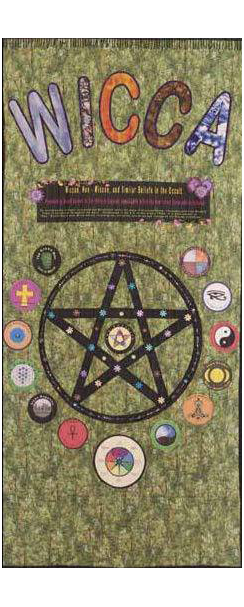
“Do whatever you will as long as it harms nobody.” (Wiccan Rede)
Wicca is a modern pagan, witchcraft religion, developed in England during the first half of the 20th century, and introduced to the public in 1954 by Gerald Gardner, a retired British civil servant. It draws upon a diverse set of ancient pagan and 20th century hermetic motifs for its theological structure and ritual practice. Wicca is a diverse religion with no central authority or figure defining it and is divided into various lineages and denominations, referred to as traditions, each with its own organizational structure and level of centralization. Established in the U.S. in the middle of the 1960s, it is most popular as “Neo-Wicca” based on Wicca but not including the initiation, mysteries and lineage of the Wicca priesthood. The Wicca panel shows symbols dating back to the Pagans and sometimes appearing in other religions as well.
Yoruba, Ifa
YORUBA, IFA
“One going to take a pointed stick to pinch a baby bird should first try it on himself to feel how it hurts.” (Nigeria)
Primarily located in southwestern Nigeria, Benin and Togo in Africa, the Yoruba religion, IFA, has only recently been officially called a religion. It has been integrally bound up with the rites and practices of Yoruba people, their geography, language and history. IFAs believe that except for one’s birth and death, events can be forecast and changed. They believe that one is born with a specific path and that divination can forecast that map. Because one’s spirit lives on after death and can reincarnate through blood relatives, ancestors exist and must be honored and consulted. One should never harm another human being or the universe because the forces of nature live within us.
Zoroastrianism
ZOROASTRIANISM
“That nature alone is good which refrains from doing unto another whatsoever is not good for itself.” (Dadistan-I-dinik 94:5)
Zoroastrianism is one of the world’s oldest monotheistic religions, founded by the Prophet Zoroaster (or Zarathustra) in ancient Iran approximately 3500 years ago. For 1000 years Zoroastrianism was one of the most powerful religions in the world and was the official religion of Persia (Iran) from 600 BCE to 650 CE. It is now one of the world’s smallest religions, with fewer than 190,000 followers worldwide. Zoroastrians believe there is one God called Ahura Mazda (Wise Lord), symbolized by fire and light, and that He created the world and revealed the truth through the Prophet, Zoroaster. Between 550 – 330 BCE, Zoroastrians developed the abstract concepts of Heaven and Hell and the concept of personal and final judgement. Zoroastrians live by the creed: good thoughts, good words, good deeds, praying several times a day and worshipping communally in a Fire Temple. They do not view any human as better or …
Art: Peace Garden
PEACE GARDEN
Designed and created by Pamela Dado (2013)
The Peace Garden represents all of the positive outcomes that come from greater understanding and tolerance of diversity. In your mind, you are encouraged to pick a flower and to continue on with great peace and love in your heart. “Quilt artist Pam Dado, owner of Creations Quilt Shop in Duluth, MN, volunteered to create the Peace Garden quilt. Her customers enjoyed watching her work along the way. Pam has a background in art and painting. This is completely her vision of what a Peace Garden might look like. I was excited to watch it evolve. The trellis and pathway that goes through it and winds off into the distance is how I experienced it in my dream. Designing, creating the garden and constructing the gate and path all took months to do. Quilting the many layers, I gather, was a horrendous task. … What an accomplishment!” ~Janet B. McTavish
Art: Watching
WATCHING
Designed, pieced, appliqued, paint dyed and embellished by Janet McTavish and quilted by Karen McTavish (2002)
This quilt has won two national awards and was a finalist at the Houston International Quilt Show in 2004.
“We live among the deer, bears, wolves, etc. in Northern Minnesota, so the subject was a natural for me. I used a number of techniques, a lot of fussy cutting and a great deal of paint to achieve the artistic yet realistic effect I wanted for a pictorial quilt.” ~Janet B. McTavish
Art: Peace Waterfall
PEACE WATERFALL
Designed and created by Deborah Sullivan (2012)
“In my dream, I carried a rock with me as I passed all the individual ‘Fath’ cubicles. I not only was learning about these different faiths, but I also was aware of the negative reaction that people including myself had when confronting different ideas, cultures, clothing styles, practices, etc. I had been asked to store all this negativity in the rock so it wouldn’t cloud my ability to learn. I knew I would always have those feelings in my rock if I wanted to hold onto them. However, when I reached the Peace Waterfall, I was encouraged to leave my rock there to be washed clean of all those negative feelings and I was glad to do so.” ~Janet B. McTavish
Deborah Sullivan, a relatively new quilter from Duluth, volunteered to design and create the Peace Waterfall. Janet gave her no instructions except to tell her about her dream. Because Janet had been reading about “near death” experiences, where people describe going through a tunnel or veil to a place filled with brilliant light and color, she felt as though she were looking through an opening in that veil when she looked t Deborah’s quilt. Since quilting the “Peace Waterfall,” Deb Sullivan has won …



